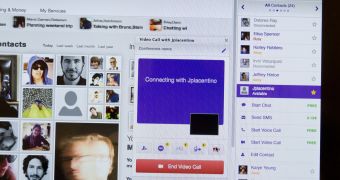WebRTC has been some time in the making, but the web-based voice and video chat technology is coming along nicely. Google and Mozilla demoed the first inter-browser chat a few weeks ago.
Now, at the Mobile World Congress, Mozilla is showcasing a proof of concept use of WebRTC, by integrating WebRTC calls with an existing phone number on a mobile device linked to a desktop browser.
Ericsson used WebRTC, the Mozilla Social API and AT&T's API Platform to devise an application which relies on the existing phone number to provide a number of calling services via the browser.
The demo uses a custom Firefox for Android build with WebRTC enabled, the feature is not available in the mobile browser by default yet.
But the more interesting use is the Social API app built by Ericsson for the desktop Firefox browser which enables users to initiate or receive calls, send or read any message they receive on their phones.
It's a very interesting use of a number of technologies only found in Firefox. It's only a demo, but it explores several ideas, some of which may prove quite useful.
Plenty of people may find it useful to screen calls or read messages without having to reach for their phones every time.
"This demonstration shows how the Web browser can perform many functions usually confined to a mobile device such as voice and video calls and SMS and MMS texting," Ericsson explained.
"Integrating communications services with Web browsers allows consumers to easily shift between devices and locations," it said.
"Additionally, the proposition will allow fast innovation to new and different applications and services – whether on a mobile device or desktop computer, through the global network of developers who work on the open Firefox platform," it added.
WebRTC if on its way to becoming a web standard, the three major components are already built into Firefox and Chrome is working on the third.
GetUserMedia handles access to the webcam and mic, a crucial part of any voice or video call technology, but the API has plenty of other uses, there are a number of apps that rely on it.
PeerConnection, the second major component, handles the voice and video data transfer between browsers, or between any app or device that implements WebRTC.
Finally, DataChannels, which only works in Firefox for now, handles arbitrary data transfers, very useful for any chat app, enabling photo sharing, text chat and so on.
The Social API, on the other hand, is a Mozilla creation and it allows web apps to be integrated into the browser, making it possible to stay connected without actually visiting the site. The Facebook Messenger for Firefox was the first app that makes use of the API.

 14 DAY TRIAL //
14 DAY TRIAL // 
